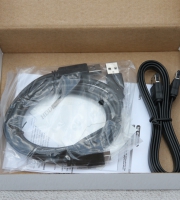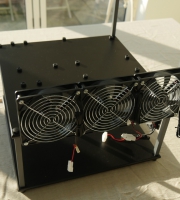


As you’ll have keenly deduced, our appendage endowed swiping supremo is posing as the hard drive’s controller. The stock checkers are our customer’s polar opposites and represent applications making write requests, whilst the items in their respective trolleys denote random and sequential segments of data, though this time, they are being written to the drive.
Of course, for Mr. Evans’s sensational scheme to catch fire, he needed enough shoppers and stock minders to engage all the checkouts, with each able to fill their trolley to the brim and manoeuvre it with the proficiency of Aryton Senna powering his way to pole in Monaco. However, no further hungry souls wandered into the store that day and try as they might to take advantage of an offer that was too true to be bad, none of our lucky trio or their devoted assistants could stack more than 32 items on their checkout’s conveyor belt for our ambidextrous phenomenon to dispatch or receive, leaving him with an abundance of next customer please signs and 655350 idle hands to scratch his puzzled head.
If fate itself were conspiring to thwart a heavenly resurgence of high-street consumerism, its cruel finger was aimed squarely at Norman’s slumped and dejected figure. Fortunately, as months passed, our customer’s genetics altered and they began to whirl their wheelers with enhanced vigour. Their stacking techniques improved, and word of the store’s extraordinarily generous promotions saturated its sleepy community. Soon, cavernous and once stark aisles were brimming with a bustling and sociable populous.
Trolleys stood docked at every checkout, buried beneath ambrosial delights. Packets, boxes, bottles, bags and jars weaved lines of irregular dominoes across the floor, twisting around pyramids of weekend deals as do myriad queues snake from ice-cream parlours on shimmering summer afternoons and the magnanimous monster of many tentacles, his juggling skills now ceaselessly sought and applied with mesmeric panache, gave every enraptured shopper his most enchanting smile as he picked and packed their produce to nourish as nature intended. Not good enough? Tough, for this analogy is hereby terminated.
The Negative Side of Nullified Volatility
As NVMe had materialised during a transitional period in the digital storage industry, when choice was more stifling than liberating, manufacturers wilfully snatched confusion from the jaws of simplicity and ensured the resulting drives took on more forms than a shape-shifter constructed from genetically modified polymorph.
I shall refrain from regurgitating information it was as taxing for me compile as for intrepid readers to assimilate, but for any literary masochists wishing to indulge in a generous portion of facts pertaining to the anti-revolutionary revolution, a reasonably coherent chronicle resides…around about here. For the rest, a refreshingly succinct alternative shall make an appearance in a couple of scrolls.
Weather we wistfully hanker after the days of swapping 25 floppy disks to savour five frames of pre-rendered animation, of man handling breeze block sized hard drives whose platters could barely accommodate a lemming’s autobiography or of securing mortgages to purchase CD-ROM drives that took longer to install windows than a for a bogus builder to install windows in a house, the aplomb of our paperless archivists lay at the mercy of four parameters;
1: The bandwidth of the interface.
2: The speed of the media.
3: The versatility of the protocol.
4: How effectively software exploited all three.
When examining the chart above, many might ask how Muhskin’s Scorpion, G.Skill’s Blade and OCZ’s Revodrive were able to keep Intel’s and Samsung’s competition honest, despite all three being native “SATA-rists” and untouched by the magic of NVme. The answer is simple, these cards cunningly circumnavigated the limitations imposed by the SATA interface and its ageing protocol by relying on multiple drives and controllers to communicate over separate PCI-E lanes.
Though they were identified as a single drive by the OS, every one consisted of four individual SSDs, each armed with a”Sandforce” controller, and ultimately linked to 8 second generation PCI-E lanes via an additional RAID controller. This yielded a theoretical bandwidth almost six times higher than would have been permissible over the SATA bus and added the ability to address three extra command queues in parallel.
For reference, I have included a set of results attained by my own beloved warhorse in the same benchmark. Discerning or returning technophiles will have probably noted that my adopted chassis since Spring 2013 was the refined flagship of Lian Li’s imperial “Armorsuit” convoy, the PC-P80N. Secluded within its silky aluminium shell was a rampant quartet of Crucial M550 drives, a terabyte a piece, hosted by Areca’s ARC-1883x, a PCI-E 3.0 x8 a dedicated raid controller card which brandished a dual core 1.2 GHZ processor and 2GB of ECC memory.
As can be observed, in terms of sequential aptitude, it outshines every rival save for Intel’s 3700, which takes the lead in the write test but falls behind on reads.
For 512K random reads and writes, it is again the best of the bunch and by an impressive margin. Scattered writes at 4k are on a par with all except the NVMe drives, while 4k random reads see it head the field once more. For 4k blocks at maximum queue depth, its reads place it fourth overall though it limps across the line last in the write test.
Altogether, the setup cost approximately £2380, which sounds extortionate but breaks down as 59p per gigabyte, making it the second cheapest on show. An arguably enticing alternative, especially for those who believed the marriage of SATA and AHCI had long, healthy years left to astound and were loathed to defend their ill-judged investments!!!
Nevertheless, one can also infer from those florid florescent bars that both Intel’s and Samsung’s solids gathered significant momentum when tasked with random reads and writes and were able to nose ahead once data chunks became smaller and command queues lengthened. Thus, even in its tender infancy, we were granted a tantalizing glimpse of this incredible protocol’s potential once applications had been primed to pose sterner tests. Such was the quantum leap it provided , that many declared every other key component in our systems would need upgrading several times before it could possibly re-emerge as a hindrance. All that remained was to ruefully cogitate over which bottle would be next to rear its ugly neck.